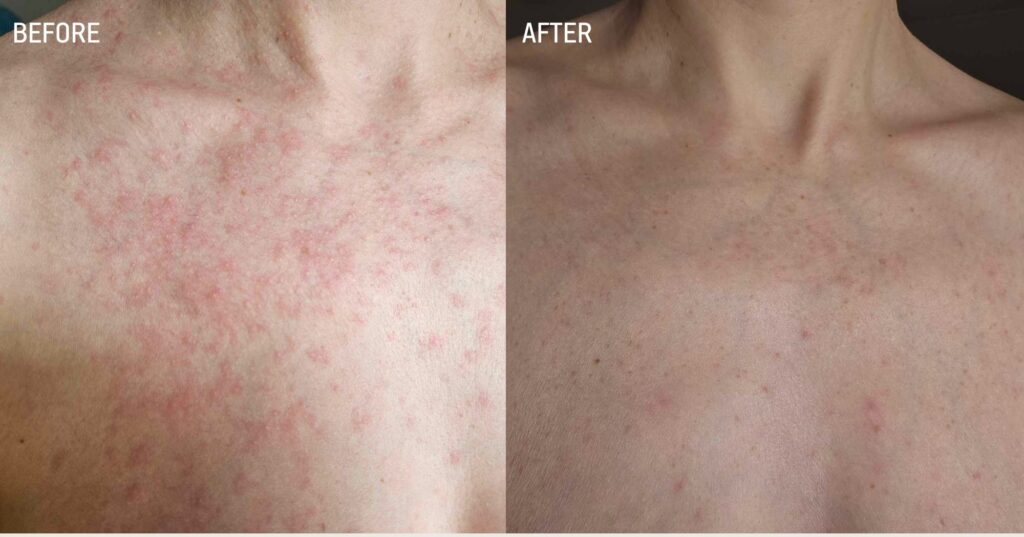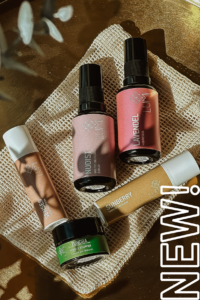
When you hear ‘allergic to the sun’, you may think of vampires, or teenage gamers who refuse to leave their bedrooms even on the nicest of days! But sun allergies are very real, and no joke to those who suffer from them. They can make even the most routine activities a challenge, and the effects of sun allergies can last for weeks!
But what actually are sun allergies, and what’s behind them? More importantly, what can those suffering do to protect themselves? Today, we answer all of these questions and more, as we explore sun allergies, their causes and potential cures, and take a look at how LUMI can help your skin stay happy and healthy this summer.
Let’s dive in!
What is a ‘Sun Allergy’?
Sun allergy is a catch-all term for several different conditions, though all affect the appearance of the skin. In the medical profession, a rash caused by exposure to the sun is called a photodermatosis. A photodermatosis can have many potential causes, both from within the body and from an external source.
Polymorphic Light Eruption
The most common sun allergy is the fantastically named polymorphic light eruption (PLE). PLE (sometimes called polymorphous light eruption in the US) is a surprisingly common skin rash that’s caused by UV exposure. In Europe, it’s thought that one in five people will suffer from PLE at some point in their life.
PLE is much more prevalent in women than men, and usually begins in early to mid-adulthood. All skin types can be affected by PLE, but it’s thought to particularly affect those with fairer skin.
PLE can present in many different ways (polymorphic means taking multiple forms), including as small red bumps, flushing red areas of skin, itchy or stinging skin, and even blisters and hives. Skin will often form hard ‘plaques’ of tough, desensitised skin that can last for several weeks after UV exposure.
The symptoms of PLE are often mistaken for heat rash (also called prickly heat, or miliaria), but heat rash is caused by overheating and the blocking of sweat glands and ducts, rather than UV exposure. Consequently, prickly heat will not last for as long as PLE and doesn’t result in desensitised skin or hardened skin plaques.
The causes of polymorphic light eruption are not fully understood, but it is thought that the skin microbiome plays a pivotal role. Recent research suggests that the rashes that characterise PLE may come about thanks to the skin secreting antimicrobial peptides, which serve as a chemical barrier for skin.
The skin releases these antimicrobial compounds in response to changes in the microbiome brought about by UV radiation. Because the rash is caused by the antimicrobial peptides and not from the UV radiation itself, PLE can last for multiple weeks after sun exposure. It also means that if we can stop disruption of the skin microbiome, we can potentially minimise PLE symptoms. But more on that later!
Other Sun Allergies
PLE is the most common sun allergy by a long distance, but there are several others. Juvenile spring eruption affects the ears, particularly in people with short hair that does not cover the ears, and can present as lumps, rashes, crusts, or blisters on the ear’s surface that usually needs medical treatment to resolve.
Actinic prurigo causes incredibly itchy rashes, as well as many of the same symptoms as PLE. It is often misdiagnosed as PLE, but can affect more of the body, including the lips, and symptoms are usually much more severe. There are dozens of other sun allergies, including chronic actinic dermatitis and hydroa vacciniforme, but these are exceedingly rare in comparison to PLE.
Some sun allergies can be caused by chemical compounds (photosensitisers) that cause otherwise healthy skin to react to UV radiation.
These photosensitisers may be ingested medicines, including several classes of antibiotics, antihistamines, and NSAIDs, topical treatments like retinoids and AHAs, or some kind of topical irritant that has found its way onto skin accidentally. Lemon juice is a famously harsh photosensitiser, causing skin to come out in angry blisters upon UV exposure. That’s sure to leave a sour taste, so be careful!
LUMI – Here to Help Soothe Your Sun Allergies!
If you’re suffering with a sun allergy, the thought of a sun-filled summer might fill you with dread. But there’s no need to worry! We’ve got you covered with some top tips and some brilliantly innovative LUMI skin solutions that will have your skin back to feeling its best in no time.
They say that an ounce of prevention is worth a pound of cure, and that’s certainly true for sun allergies.
Whilst it is impossible to avoid the sun altogether, those with sun allergies may find that keeping out of sunlight during peak UV strength hours (usually between 11am and 3pm) can reduce the onset of skin rashes significantly. Covering more skin or using stronger SPF cream during these hours may save you a lot of bother down the line!
Sunbrero Aloe Serum with Plant Stem Cells and Melatonin
We recommend complementing your SPF cream with our Sunbrero Aloe Serum. As PLE has been shown to affect and be affected by the skin microbiome, reacting to imbalances in the microbiota on the skin’s surface, it’s a good idea to try and keep your microbiome as healthy and balanced as possible, both before and after sun exposure.
Sunbrero has two cutting-edge plant stem cell actives that are specifically designed to help the microbiome deal with UV exposure. The first, Photobiome™, stimulates the skin microbiota’s own photo-defence systems, drastically increasing the amount of microbes that survive sun exposure.
Photobiome™ cannot protect all microbes, however, and it’s still possible for your microbiome to become imbalanced after sun exposure – or already be experiencing dysbiosis! That’s why we’ve also added another plant stem cell active to Sunbrero that is specifically designed to rebalance the skin microbiome.
Using skin bacteria’s own chemical communication channels, this state-of-the-art active ingredient biohacks the microbiome, encouraging desirable bacteria to multiply, and minimising the spread of pathogen-associated bacteria. We may be biased, but we think it’s some of the smartest skincare you’ll find anywhere!
Spoilt in Spain presents a richly hydrating aloe gel designed to deeply moisturize and naturally enhance your tan. Enriched with tanning intensifiers and infused with the prebiotic Photobiome™ from plant stem cells, it actively boosts your skin’s microbiota’s photoprotection systems while acting as a potent antioxidant.
It’s versatile too! You can use it daily as a moisturizer or mix it into your SPF cream for added benefits. After sun exposure, it becomes even more essential. Applying it post-sun helps your skin’s microbiota recover faster and replenishes lost oils, leaving your skin feeling rejuvenated and hydrated.
Improving the Skin’s Condition
Of course, even with the best protection, you may still suffer from sun allergy-related rashes. Most cases of PLE will resolve on their own, though you may wish to seek medical treatment if symptoms refuse to clear. Your doctor may prescribe you strong antihistamines or steroid creams.
For mild cases of PLE that will eventually resolve on their own, treatment should focus on soothing skin and improving its general condition.
LUMI’s Lullaby Rescue Balm has been specially designed to nurture skin and assist repair and renewal. It’s packed full of zinc, which is lauded for its ability to soothe skin complaints, speed up recovery, and protect skin from external stressors, including UV radiation and pathogens. Lullaby has everything you need to soothe skin and leave those dry, itchy skin plaques behind!
The pictures show Mirjam’s skin which is affected by sun allergy. To alleviate the symptoms, she used the Lullaby+Sunbrero combo 2x a day. The picture on the right shows the results after 5 days of continuous use!

A trusty moisturiser is vital as skin begins returning to normal. The hypoallergenic, prebiotic-infused Bio-Klinik Moisture-Lock Body Cream is specially designed to provide gentle nourishment and protection to skin without aggravating the skin’s surface. This award-winning moisturiser is suitable for skin suffering from a host of complaints, including PLE, and caters to the rebalancing and protection of the microbiome as well as skin.
So, if you have sun allergies, there’s no need to suffer this summer! Remember to stay protected, use common sense, and treat your skin with the kindness it deserves. With a little help from us here at LUMI, you’ll be back to feeling that summertime satisfaction in no time at all!
References:
-
DermNet, (2006). Actinic prurigo. https://dermnetnz.org/topics/actinic-prurigo
-
DermNet, (2008). Juvenile spring eruption. https://dermnetnz.org/topics/juvenile-spring-eruption
-
DermNet, (2016). Photosensitivity. https://dermnetnz.org/topics/photosensitivity
-
Guerra, K.C., Toncar, A., Krishnamurthy, K. (2023). Miliaria. Statpearls. Treasure Island, FL. https://www.ncbi.nlm.nih.gov/books/NBK537176/
-
Kadurina, M., Kazandjieva, J., & Bocheva, G. (2021). Immunopathogenesis and management of polymorphic light eruption. Dermatologic therapy, 34(6), e15167. https://doi.org/10.1111/dth.15167
-
Mayo Clinic, (2024). Sun allergy. https://www.mayoclinic.org/diseases-conditions/sun-allergy/symptoms-causes/syc-20378077
-
Medscape, (2022). Actinic Prurigo Differential Diagnoses. https://emedicine.medscape.com/article/1120153-differential?form=fpf
-
Mioduszewski, M., & Beecker, J. (2015). Phytophotodermatitis from making sangria: a phototoxic reaction to lime and lemon juice. CMAJ : Canadian Medical Association journal = journal de l’Association medicale canadienne, 187(10), 756. https://doi.org/10.1503/cmaj.140942
-
NHS, (2024). Polymorphic light eruption. https://www.nhs.uk/conditions/polymorphic-light-eruption/
-
Oakley, A.M., Ramsey, M.L., (2023). Polymorphic light eruption. Statpearls. Treasure Island, FL. https://www.ncbi.nlm.nih.gov/books/NBK430886/
-
Patra, V., & Wolf, P. (2016). Microbial elements as the initial triggers in the pathogenesis of polymorphic light eruption?. Experimental dermatology, 25(12), 999–1001. https://doi.org/10.1111/exd.13162
-
United States FDA, (2024). The Sun and Your Medicine. https://www.fda.gov/drugs/special-features/sun-and-your-medicine
-
Zarfl, M., Patra, V., Bordag, N., Quehenberger, F., Golob-Schwarzl, N., Gruber-Wackernagel, A., & Wolf, P. (2024). Eradication of skin microbiota restores cytokine production and release in polymorphic light eruption. Experimental dermatology, 33(3), e15034. https://doi.org/10.1111/exd.15034

















